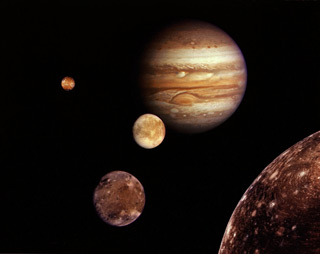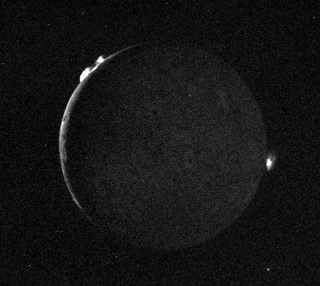When I was in high school I started to get into music. I didn’t think of it this way at the time, but I was probably trying to steer away from the direction of my dad. I just wanted to do my own thing. So I studied music at the University of Arizona for four years and actually got a music degree. When I was about halfway through the program I realized that my real interests and talents were in science. I still loved music, so I finished that degree, but I also ended up earning a degree in physics. To this day, a favorite pastime is listening to music and plinking away at the guitar or piano.
Jupiter and its moons: Jupiter and its four planet-sized moons, called the Galilean satellites, were photographed in early March 1979 by Voyager 1 and assembled into this collage. Io is the moon in the upper left corner of the image, and is the moon that is closest to Jupiter.
Credit: NASA/JPL
I went to Caltech in physics for graduate work with fairly open ideas about what I might do, including high-energy physics and elementary particles and things like that, because these areas grabbed my attention. I really wasn’t sure I wanted to do astrophysics but luckily I stumbled into an excellent astrophysics group. What really enticed me to join the group was they had an instrument on the Voyager spacecraft. Voyager was flying by Jupiter and Saturn to study cosmic rays while the spacecraft was between the planets. I worked on the detector and helped calibrate the instrument by taking it to a particle accelerator to measure the signals for known particle inputs. When Voyager flew by Jupiter, the detector picked up a very unusual particle signature, which turned out to be energetic oxygen and sulfur nuclei from the volcanoes of Io, and I ended up doing my thesis on that. I had so much fun with my thesis that I became convinced astrophysics was what I wanted to do!
Io - crescent with plumes: Voyager 2 took this picture of Io July 10, 1979, from a range of 1.2 million kilometers (750,000 miles). The image was part of an extensive sequence of "volcano watch" pictures of Io. The sunlit crescent of Io is seen at the left, and the night side illuminated by light reflected from Jupiter can also be seen. Three volcanic eruption plumes are visible on the limb. All three were previously seen by Voyager 1. On the bright limb Plume 5 (upper) and Plume 6 (lower) are about 100 kilometers high, while Plume 2 on the dark limb is about 185 kilometers high and 325 kilometers wide. The "volcano watch" sequence of pictures told us that these volcanoes are persistent, change with time, and are larger and last longer than those on Earth.
Credit: JPL



